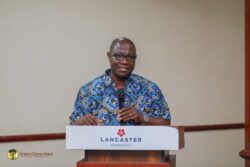According to the ILO’s 2017 global report (2012-2016), an estimated 152 million children worldwide are engaged in child labour, accounting for almost 10 percent of the child population in the whole world. The report says approximately 73 million children between the ages of 5 and 17 are engaged in hazardous; 35.4 million children between the ages of 5 and 14, and 37.1 million between the ages of 14 and 17.
Child labour is more predominate in the Agricultural Sector, accounting for 71 percent of all those in child labour, representing around 108 million children (Rules of the Game, an Introduction to the Standards Related Work of the ILO, Centenary Edition) page 43.
Out of the figure, Ghana has 21.8 per cent of children in child labour. These children may be trapped in quarry, mining, head porterage, domestic servitude, farming and sex exploitation among others.
While global efforts are being taken to ensure that countries put in place pragmatic measures to eliminate and end child labour by 2025, Ghana, as a country has never relented in its efforts together with stakeholders in the fight to tackle the issue of Child labour and its worst forms.
More importantly, Ghana has chalked great successes so far including the ratification of fifty-one (51) ILO Conventions of which eight (8) are fundamental Conventions.
LEGAL AND POLICY FRAMEWORK
Typically, the Government of Ghana recognising that child labour has adverse effects on children’s rights, health and education, and constitutes a serious hindrance to the achievement of national education and human resource development goals, has developed a legal and policy regime to address child labour comprehensively.
The key International Instruments and relevant national laws enacted to deal with child labour are Convention 138 concerning Minimum Age for admission to employment and Convention 182 on the elimination of the worst forms of child labour. Beyond these, Ghana has enacted various legislations which also find their root in the 1992 Constitution of the Republic of Ghana. These laws include the following:
The Children’s Act, 1998 (Act 560); the Human Trafficking Act, 2005 (Act 694); and the Human Trafficking Regulations, 2015 (L.I. 2219); the Criminal Offences Act, 1960 (Act 29) as amended by the Criminal Offences (Amendment) Act, 2012; the Juvenile Justice Act, 2003 (Act 653); the Labour Act, 2003 (Act 651); and the Labour Regulations, 2007 (L.I. 1833).
These laws are aimed at providing effective protection to children and preventing them from being victims of child labour.
INSTITUTIONAL ARRANGEMENTS
There is a robust Institutional Framework which has the National Steering Committee on child labour (NSCCL) as the apex body providing for effective networking of stakeholders and partners. The Child Labour Unit (CLU) under the Labour Department (LD) of the Ministry of Employment and Labour Relations (MELR) is the National Secretariat of the National Steering Committee and coordinates all child labour interventions in the country.
Again, this arrangement provides for lead agencies to implement specific activities towards the elimination of child labour. It also provides for the identification of collaborating partners which is an embodiment of private sector, development partners, CSOs, NGOs etc in complementing the efforts of the Lead Agencies and the National Secretariat.
Again, the Institutional arrangement provides for various sub-Committees that handle specific thematic issues which include Policy Planning and Implementation; Monitoring and Evaluation; Resource Mobilisation; Advocacy and Communication; and importantly Child Labour, Social Protection and Labour Inspections.
Ministries, Departments and Agencies have desk officers who coordinate child labour interventions in their various institutions.
HAZARDOUS WORK
In order to deal with the issue of hazardous work , Government has taken measures to improve access to education in its efforts to implement the constitutional provision of Free Compulsory Universal Basic Education (FCUBE) through the expansion of school infrastructure, continues training of competent teachers, Capitation Grant covering 5,864,055 pupil in all public basic schools from kindergarten to Junior High School and School Feeding Programmes covering about 10,000 basic schools with a student population of 2,939,555.
Again, between 2010 and 2020, Government progressively reduced the average distance to schools from 4.5km to about 2.1km thus, increasing school enrolments at the primary and Junior High School to 98% and 95% respectively. Government introduced the Free Senior High School policy in 2017 and this has facilitated over 300,000 children who hitherto could have ended in child labour now have access to free secondary education.
Government has collaborated effectively with Social Partners, the Private Sector, Development Partners (ILO, UNICEF, USDOL, EU etc.) to take pragmatic measures through prevention, protection, prosecution and partnership in the design and implementation of the National Plan of Action for the Elimination of the Worst Forms of Child Labour (2009-2015) and the second phase (2017-2021). It involved awareness raising, monitoring, removal and reintegration of child labourers and children at risk and ensure their enrolment into schools and vocational training institutions.
To help prevent children from engaging in hazardous work on cocoa farms, Government has since 2000 implemented mass cocoa spraying, mass pruning, fertiliser application and subsidies, artificial pollination, extension services undertaken by adults and farmer groups. These interventions further contribute to improving cocoa productivity and income of farmers hence reducing poverty and vulnerability which are known to be the main causes of child labour.
In 2010, the Governments of Ghana and Cote d’Ivoire, representatives from the International Chocolate and Cocoa Industry and the USDoL, signed a Declaration and Framework tied to the Harkin-Engel Protocol to take action towards the goal of achieving 70% reduction in the worst forms of child labour in the cocoa sectors of the two (2) countries in the aggregate by 2020. This effort resulted in tremendous improvement in the fight against child labour culminating in a Public-Private Partnership initiative.
HAZARDOUS ACTIVITY FRAMEWORK (HAF)
In the determination of hazardous types of work, Government has since 2008 developed, in accordance with Article 4 (1)(2) of the Convention, a comprehensive Hazardous Activities Framework (HAF) for the Cocoa Sector in 2008 and in 2012 a General HAF on seventeen (17) other sectors.
The document is a reference point for child labour-related surveys including the 2014 National Survey conducted by the Ghana Statistical Service and the UCW Report of 2017, entitled” Not just”. The document is currently under review.
UNDER THE ILO-IPEC PROJECT
In respect of monitoring child labour, the Community Child Protection Committees (CCPCs) are the fulcrum around which the child labour monitoring system revolves. They monitor and identify child labourers and children at risk and refer them for remediation services. It is worth noting that a total of 2,612 CCPCs have been formed and as a result, 7,543 children at risk and in child labour cases have been identified through the routine monitoring exercises.
To conclude, from the advance argument, it is worth noting that the Government of Ghana has never relented in its efforts at eliminating and eradicating child labour. Children are our future heritage, “so let’s all stop child labour now”.
The writer is a staff of ISD and the Head of Public Affairs of the MELR










